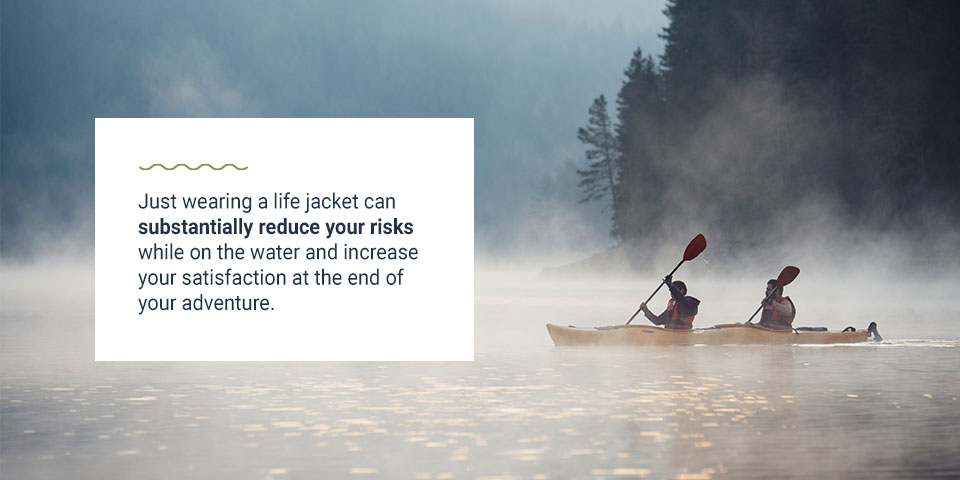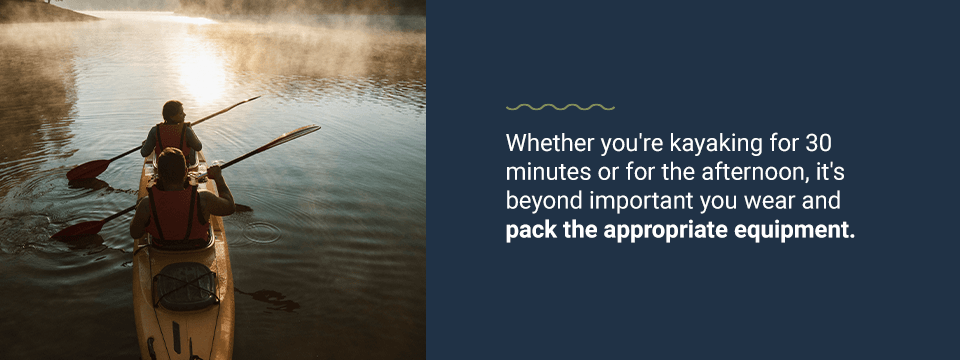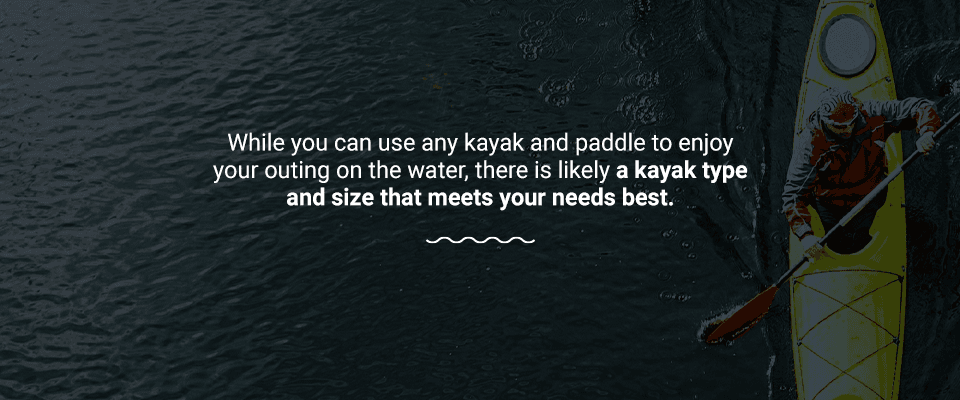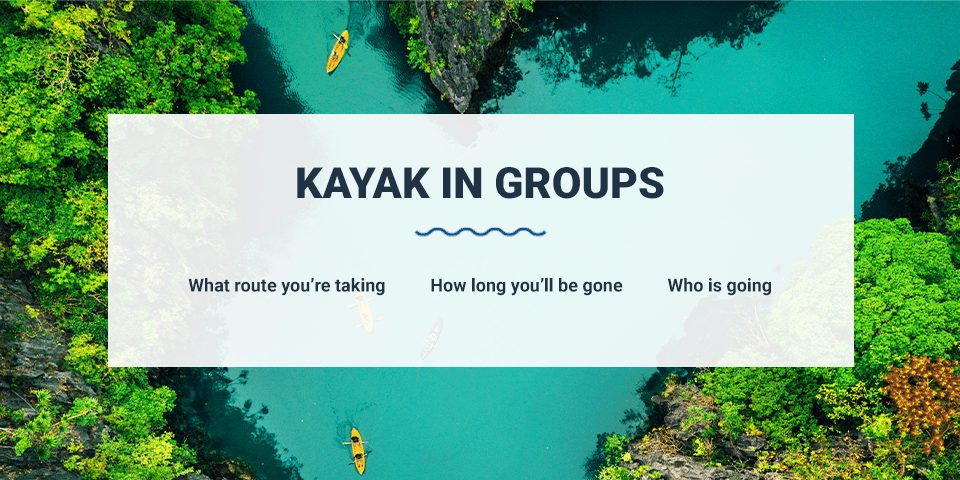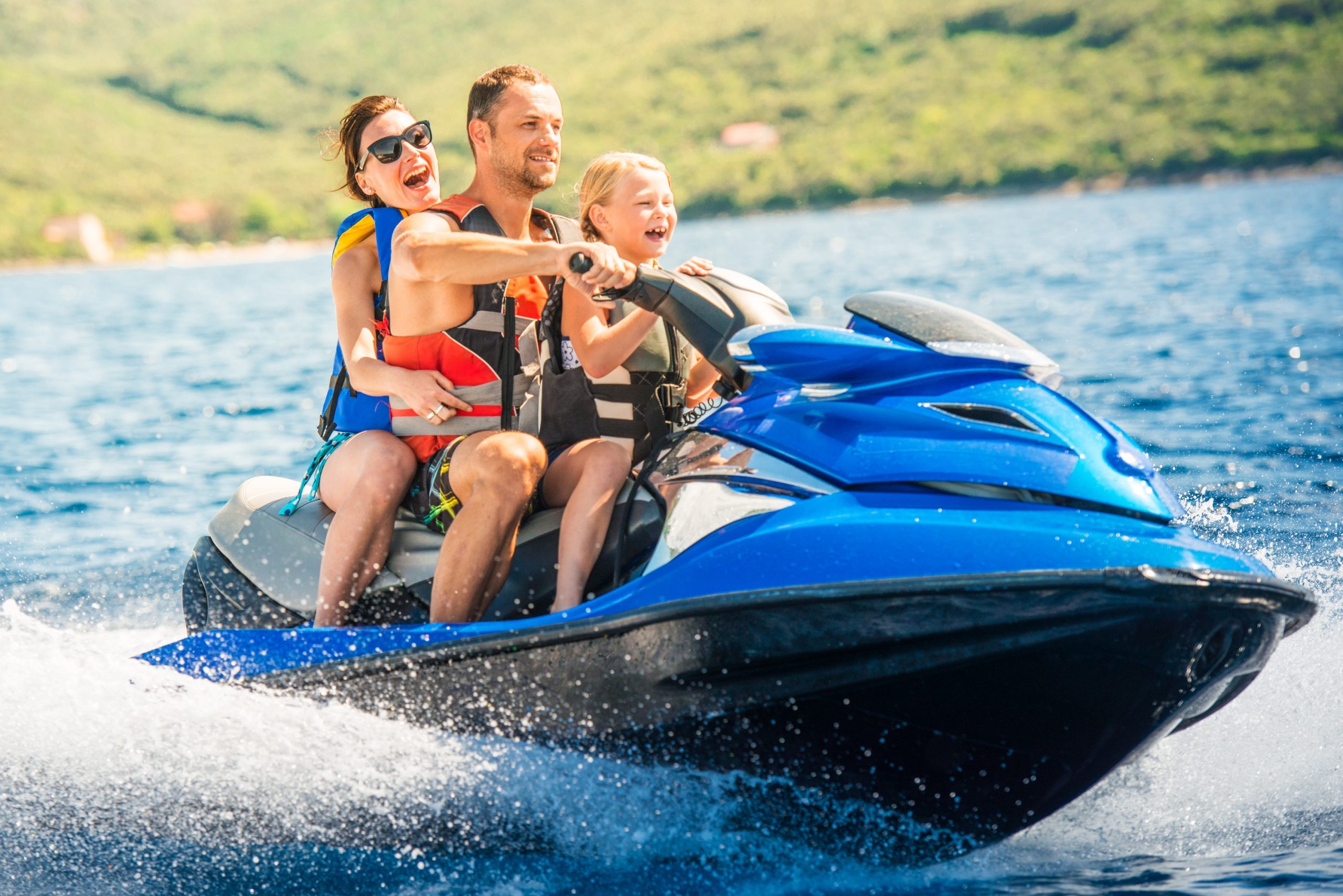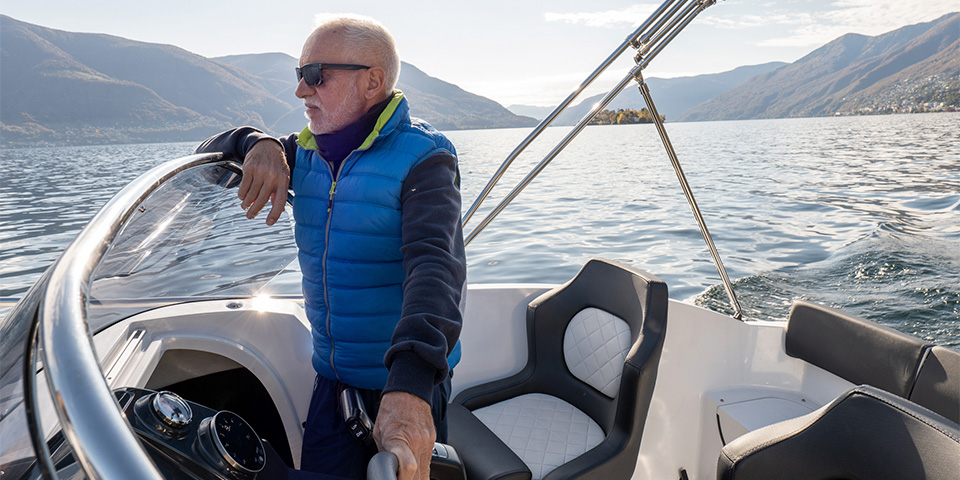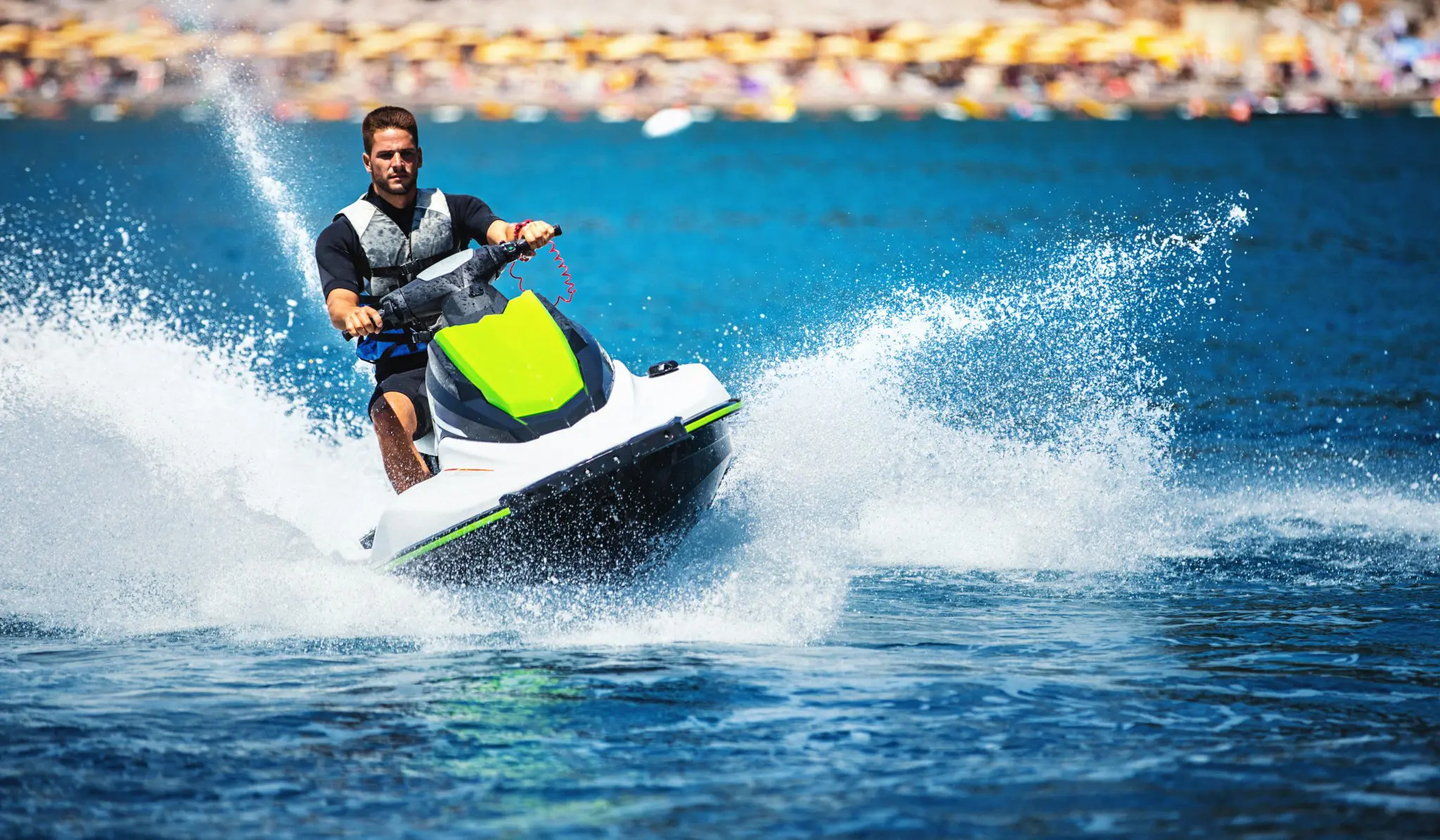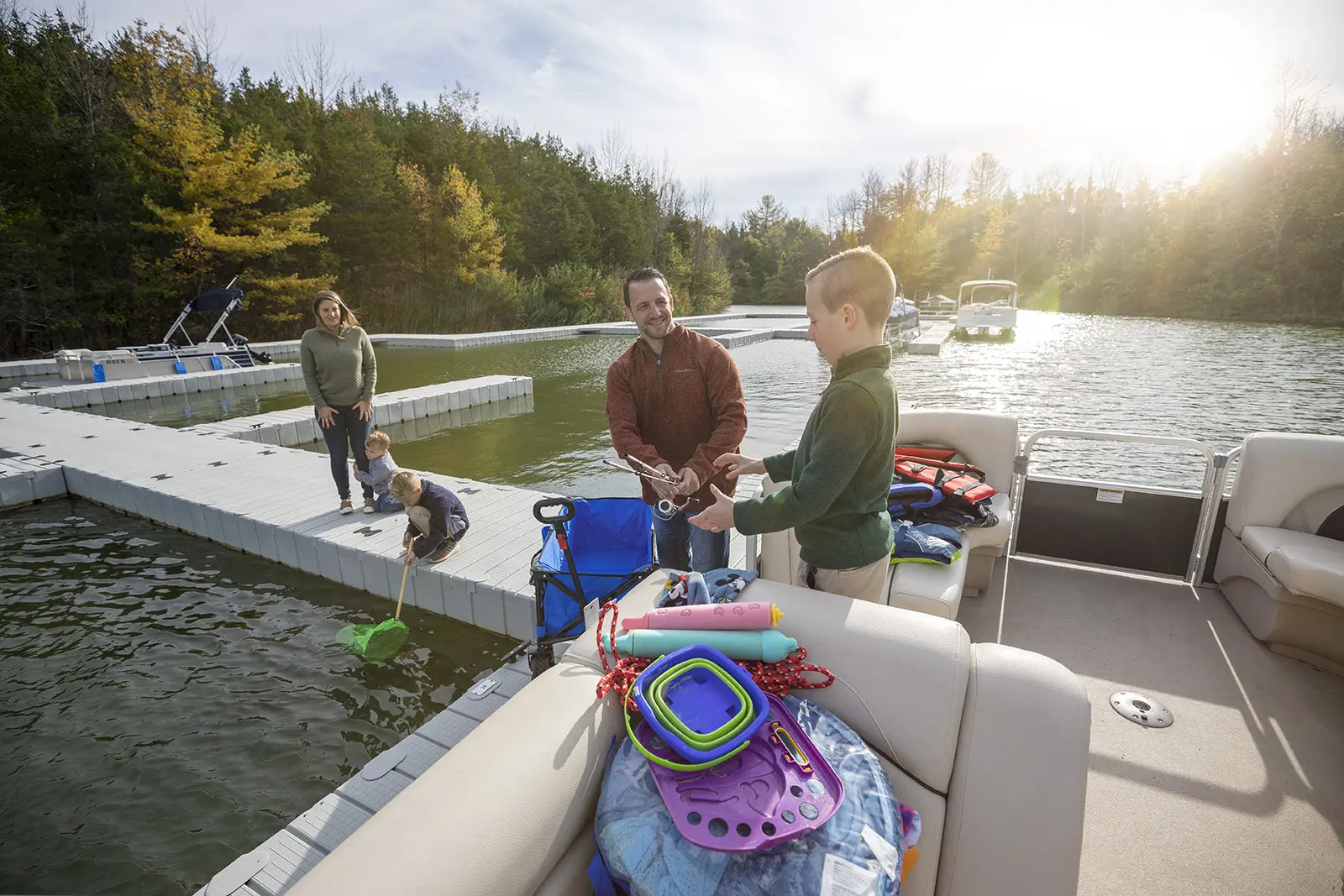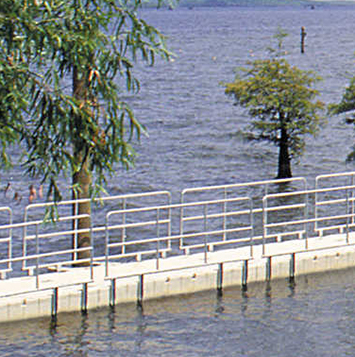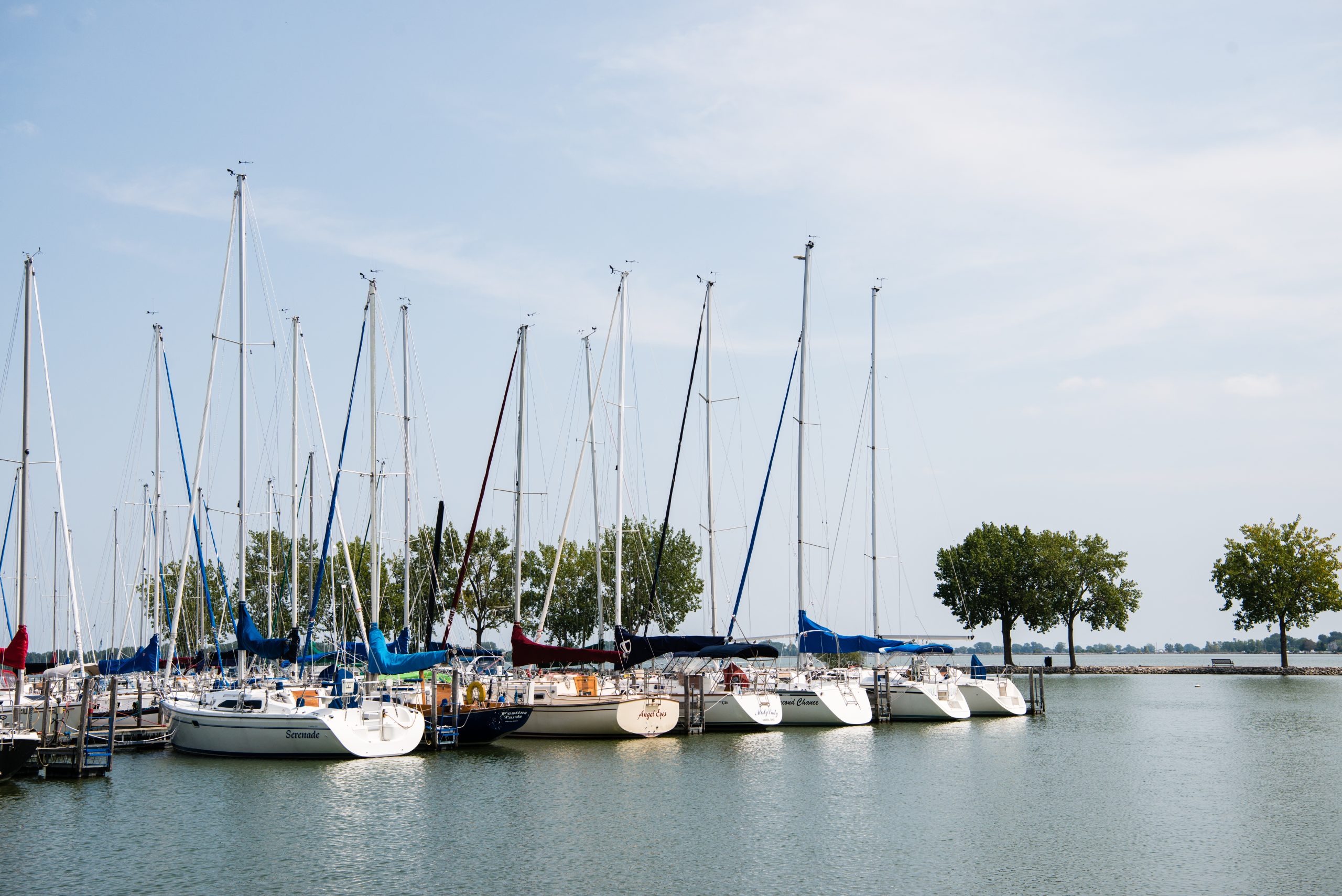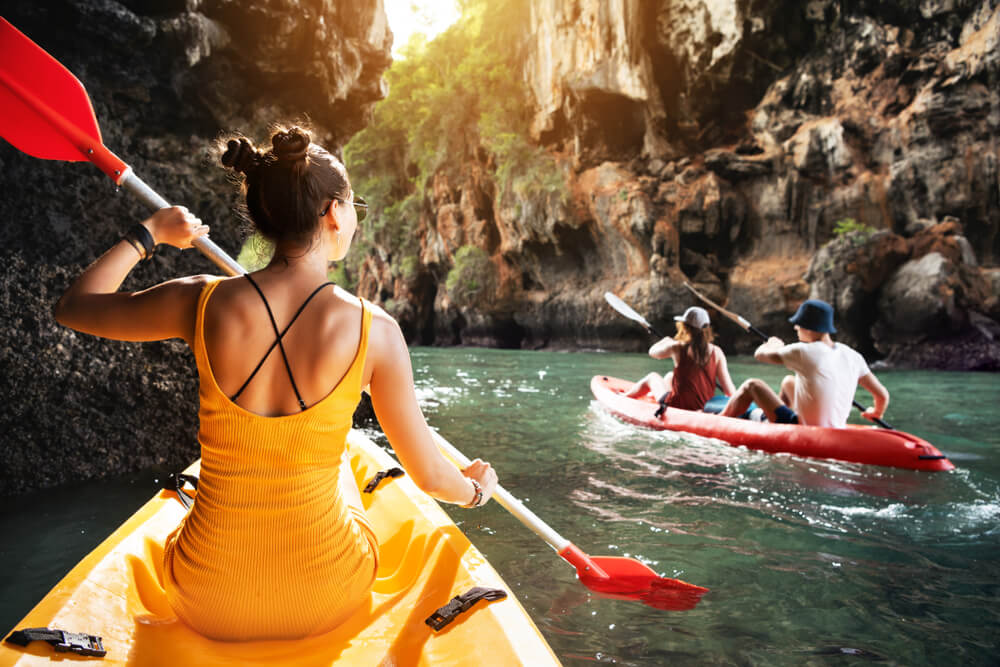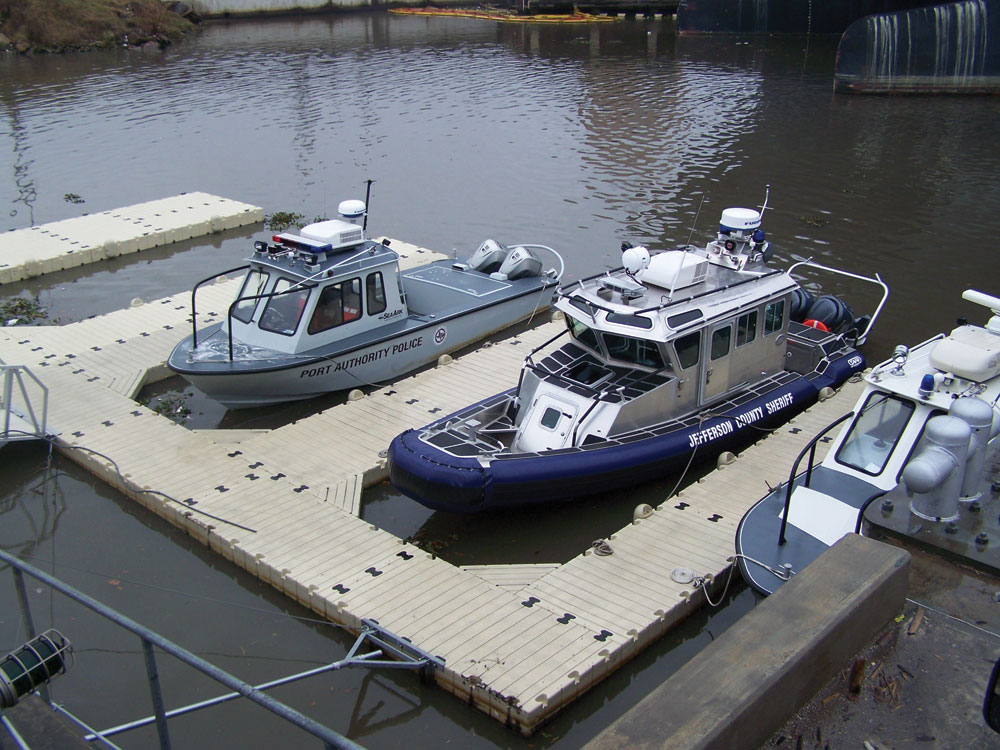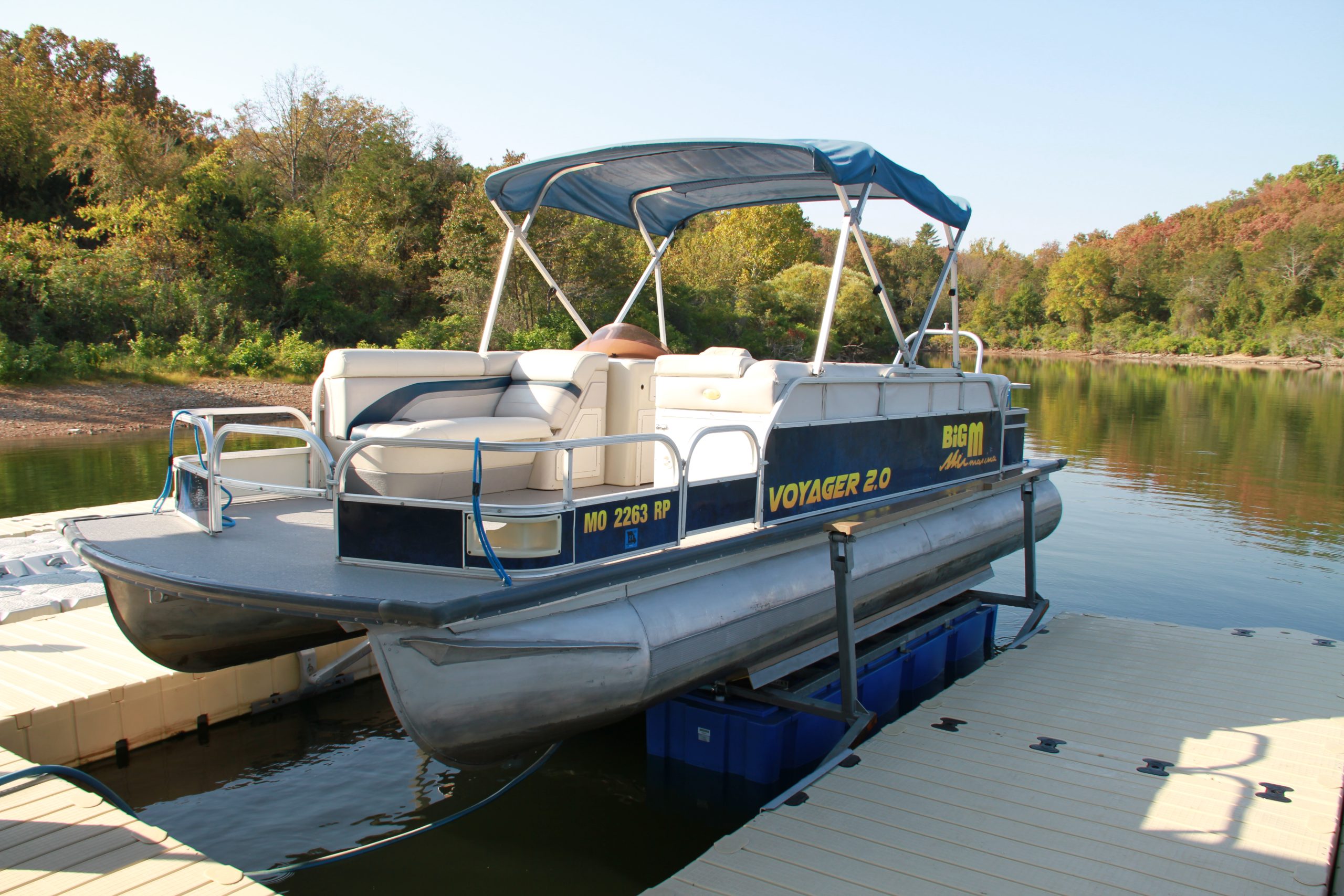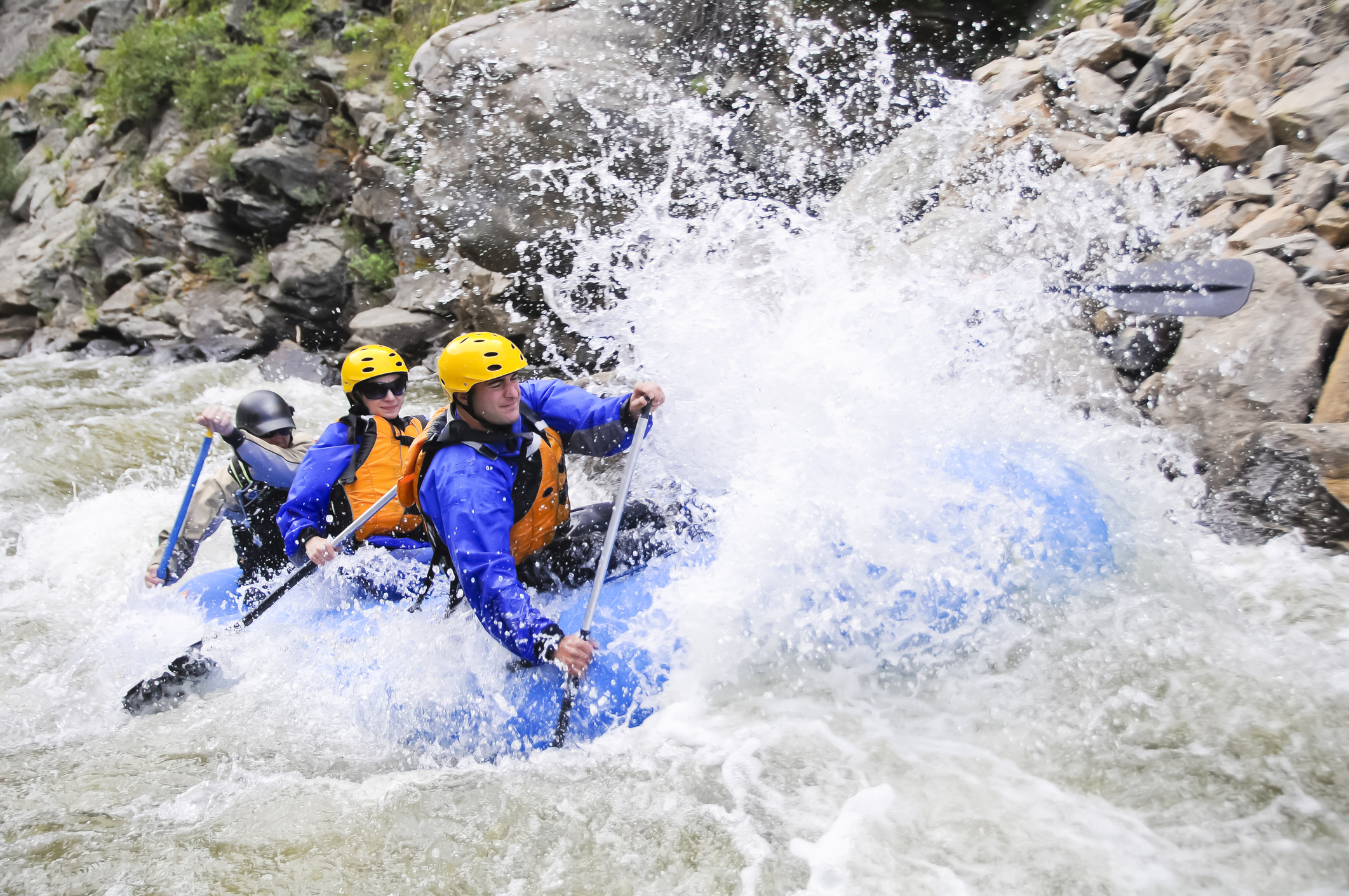Filters
Kayak Safety 101
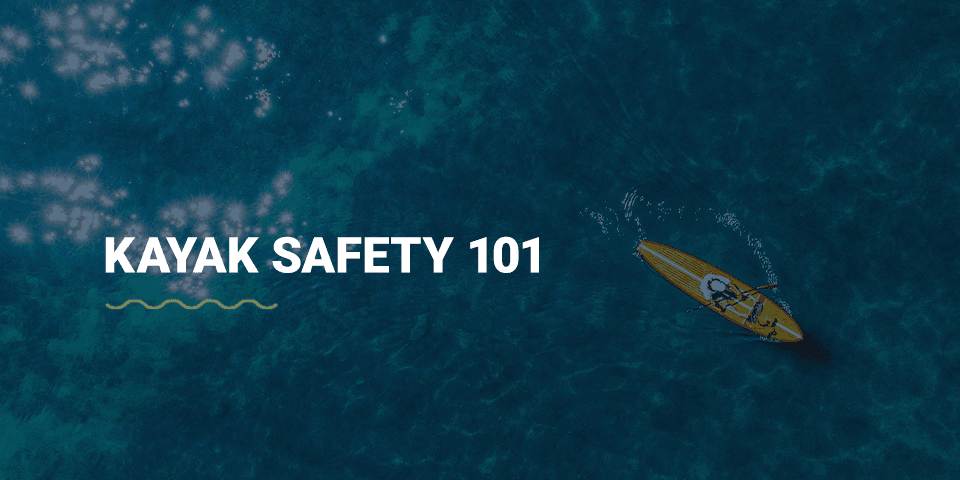
A sunny and bright afternoon of kayaking in a river, pond, lake or ocean promises a fun and relaxing experience for you, your friends or your family.
You can spend the day enjoying the beauty of the sparkling and calm water and the excitement of gliding on the water. On the other hand, kayaking can deliver a dangerous adventure if you do not follow important safety procedures.
Whether you end up with painful bruises instead of sweet memories, it all boils down to kayaking safely.
Consider this guidebook your kayak safety 101 course on how to kayak safely.
In this handbook, you’ll learn:
- Why kayak safety is important
- What kayaking mistakes to avoid
- How to kayak safely
After following the kayaking safety precautions you’ll read in this guide, you’ll feel equipped and confident about your next breathtaking adventure.
Ready to make your next kayaking a relaxing and fun experience? Let’s dive in!
Table of Contents:
- Why is Kayak Safety Important?
- Tips for Kayaking Safety
- Common Kayaking Mistakes to Avoid
- Add Fun and Ease to Your Kayaking
Why Is Kayak Safety Important?
Why should you take kayak safety seriously?
Just like any watersport, your level of satisfaction and excitement depends on how healthy you are at the end — and your level of health depends on how well you followed simple safety precautions.
For example, according to a Washington State Park report, of those who drowned in a boating accident, 84% weren’t wearing a life jacket. What does this mean? Just wearing a life jacket can substantially reduce your risks while on the water and increase your satisfaction at the end of your adventure.
Here are five reasons why kayak safety is important:
- Stay safe on the open water: Kayaking takes you away from the confines of a pool. You’re in the open water on a lake or ocean and need to follow tips for kayaking safely because factors like the wind and weather can make the water dangerous.
- Avoid drowning: Kayakers who do not follow kayaking safety precautions increase their risk of drowning. For example, if someone chooses to go out on the water without a life jacket, they’re putting themselves at risk in the event of an accident.
- Protect against injuries: You can get sunburned while out kayaking, but beyond that, you could also injure your arms, wrists, head, and more. Following safety guidelines will help you reduce and prevent your chance of injury so you can head back out sooner.
- Navigate wildlife: Whether you want to kayak in a nearby pond or the open sea, you’ll likely encounter some wildlife. For example, some ponds and rivers may have alligators in them. Following safety precautions will help you avoid such areas or safely navigate them.
- Continue kayaking: Whether you come out of your kayak excited and anticipating the next adventure or hurry out of the water vowing never to go back again is determined by how safely you go about kayaking.
When it comes to kayak safety, everyone can agree on this: Paddling on your favorite lake or ocean with a bunch of friends — or with your family — and riding through waves and currents is an exhilarating experience.
If you want to keep doing it, though, you need to safely return to shore each and every time.
That’s why it’s important to learn and follow kayaking safety tips because those tips will help you — and everyone you kayak with — kayak safely.
Tips for Kayaking Safety
Here you’ll find over 20 tips for kayaking safety.
With these tips, you’ll have everything you need to:
- Prepare for a fun adventure
- Enjoy every bit of the experience
- Get ready to go back in the water — even while you’re coming out
To make it easy for you to follow and remember, you’ll find these safety tips for kayakers split into three groups:
- Weather and environment safety tips for kayakers
- Equipment safety tips for kayakers
- Personal safety tips for kayakers
Six Weather Safety Tips for Kayakers
Here are six environment and weather tips for kayaking safely:
1. Know the Temperature
Consult the weather forecast for the day to ensure the temperature isn’t too high or too low.
When you know the temperature, you can pack and dress accordingly. For example, pack sunscreen and a neck gaiter for those clear summer days.
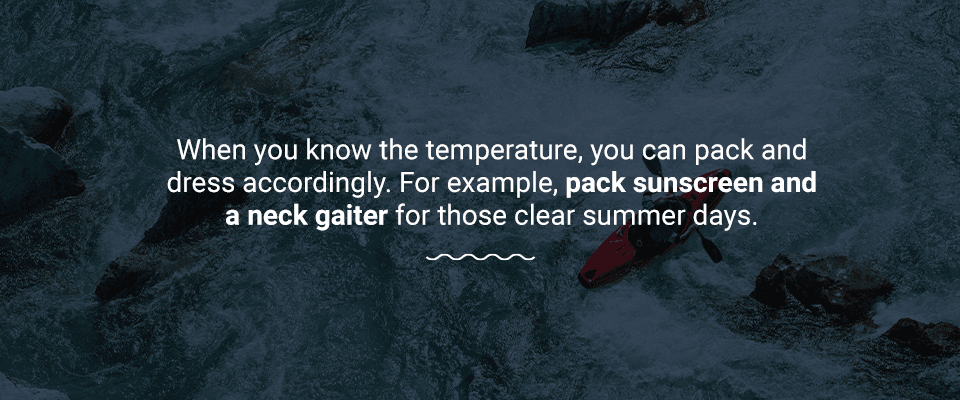
2. Measure Water Temperature
Check the temperature of the water before heading out.
If the temperature is lower than 60 degrees Fahrenheit, make sure you go with the right clothing to protect you from hypothermia in case you get wet or fall into the water.
3. Check Water Level, Wind and Forecast
Consult the weather forecast to know the expected water level if kayaking in a river.
If you want to kayak on a lake or the ocean, check to know if the forecast predicts high winds or heavy waves.
Taking the time to look at the forecast will ensure you don’t:
- Get caught in heavy waves
- Capsize
- Get pushed further from shore
4. Stay in Visible Sight
Kayak close to shores and ensure you’re always in plain sight when kayaking.
You should also avoid areas with heavy watercraft traffic — like speed boats and jet skis — since they can create heavy unnatural currents that make kayaking difficult and even dangerous in some instances.
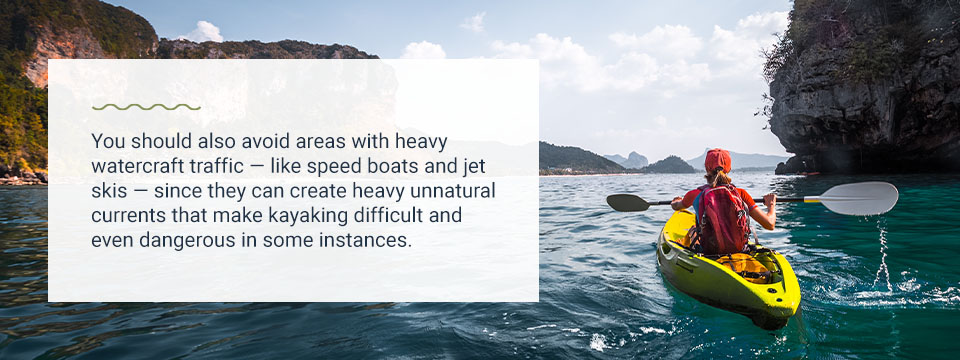
5. Know the Wildlife
What kind of animals are in the water where you want to go kayaking, and do you have to worry about them?
For example, someone kayaking in Texas might see alligators in the water. While many people choose to kayak in these areas of Texas, you have to make the best — and safest — decision for yourself and those kayaking with you.
6. Avoid Kayaking in Extreme Weather Conditions
Don’t fall for the urge to paddle in:
- High winds
- Extreme temperatures
- Fog
- Thunderstorms
- Large swells
- Nighttime hours
Even as an experienced kayaker, you should avoid kayaking during extreme weather conditions and at night. Instead, stick to daylight hours and beautiful days.
Six Equipment Safety Tips for Kayakers
Your equipment is critical. Whether you’re kayaking for 30 minutes or for the afternoon, it’s beyond important you wear and pack the appropriate equipment.
Here are six equipment tips for kayaking safely:
1. Wear Appropriate Clothing
Purchase the right clothing to help you counter the temperature when you get out in the water.
Getting a dry or wet suit can help keep you comfortable and warm in cold temperatures. For days with high temperatures, wearing a hat and shirts with long sleeves can protect your body from getting sunburn.
2. Use a Helmet and Flotation Device
If your kayak flips, capsizes or encounters another watercraft, a helmet, life jacket or personal flotation device will help keep you afloat. A whistle, or any other signaling device, can also help in emergencies.
You can make this kayak safety tip even more effective by creating a signaling code your kayak group can use. For example, use a single whistle to issue an alert and a second to indicate an emergency to your team.
3. Have a Life Jacket That Fits
Your life jacket should fit you properly without being too tight or too loose.
4. Get a Kayak That Suits You
While you can use any kayak and paddle to enjoy your outing on the water, there is likely a kayak type and size that meets your needs best.
For example, a few types of flat-water and whitewater kayaks include:
- Sit-on-top kayaks
- Touring kayaks
- Playboats
Ensure you purchase the best quality kayak with the best paddle to go with it. You should also consider purchasing a spare paddle in case your paddle breaks.
5. Pack Navigation Devices
Pack navigation devices may include a physical map of the area and a compass. If you’re going for long kayaking trips, a physical map and a compass can ensure you don’t get lost — even when you enter low network or connectivity areas.
A cell phone or any radio communication device can help you communicate with those kayaking with you and people on the shore. In addition to that, a headlamp can help you navigate the water in low visibility areas.
6. Bring Supporting Items
A backrest for your kayak, a dry bag to store your supplies and sunglasses can make your kayak trip even better.
Besides these items, you should also pack a bilge pump or bailer in case your kayak gets flooded with water.
If you’re looking for more ideas on what to bring when kayaking, check out this ultimate kayaking trip checklist.
10 Personal Safety Tips for Kayakers
Whether you’re kayaking with friends or family, it’s important to ensure your safety, and then the safety of your crew.
These are 11 personal tips for kayaking safely that can help you get started with maximizing your safety and the safety of those around you:
1. Consult Local Boating Rules
Ensure you read the local boating regulation of the area before going into the water.
For example, some states in the U.S. mandate helmets and life jackets — and you should too on your adventures.
Consulting the local requirements will help you kayak safely and on the right side of the law.
Checking the local boating rules can also inform you about weather patterns, shoreline conditions, alternate routes in an emergency and local wildlife in the water.
2. Kayak Sober
Never go into the water under the influence of alcohol. If you take prescription medicines that advise against driving or operating heavy equipment after taking, stay on land.
3. Do an Equipment Check
Check your equipment for wear or tear before going in — especially if they have been in storage for a long time. Ensure your kayak is in perfect form, your life jacket or floatation device is ready to go and you have your supplies.
You can make sure you remember to do an equipment check by bookmarking or printing out this kayaking checklist so you don’t miss anything.
4. Practice
Take classes to strengthen your kayaking and paddling skills and avoiding testing yourself on real water by yourself. Always get proper expert instructions before sliding into the water.
If you’re a beginner kayaker, start in shallow and calm waters with experienced kayakers — they can help you learn and practice kayak safety.
As your skills and abilities increase, you can take on new challenges — but never go multiple levels above your skill level.
5. Learn Basic First Aid
Ensure you understand basic first aid before you head into the water. This knowledge will enable you to deliver first aid treatment in case of an emergency before help comes.
You should also learn the basics of self-rescue — like getting on the kayak from the water, flipping the kayak, and more — before going in the water.
6. Kayak in Groups
Never kayak alone.
Have at least one person kayaking with you. You should also ensure your kayaking buddies and somebody on the shore knows:
- What route you’re taking
- How long you’ll be gone
- Who is going
7. Come Prepared
No matter where you kayak, from rivers to oceans to lakes, go prepared.
Bring food and fresh water supplies to stay active and hydrated. Since kayaking is an energy-intensive activity, you’ll need all the strength you can get.
8. Take Swimming Lessons
Learn how to swim before kayaking. It is essential you know how to swim before you go kayaking. You should know how to safely get in and out of the water from your kayak.
9. Do a Health Check
Before hitting the waters, ensure you’re in good physical and mental health.
Kayaking is physically and mentally tasking, and you don’t want to find yourself without energy when you need to paddle through unexpected conditions or paddle your way back to shore after you’ve gone far into the water.
10. Prioritize Learning
Take time to practice and master your paddling skills, swimming skills, safety techniques and getting on and off your kayak before entering the water. Open water is not the best place to learn these skills.
With these kayaking safety tips, you can ensure you return from every adventure excited to go back again. If you follow these tips, you’ll start thinking of your next kayaking adventure before even getting out of the water.
Common Kayaking Mistakes to Avoid
A lot can go wrong when kayaking, especially as a beginner. While some of these mistakes are mild, others are life-threatening.
What are some of the common kayaking mistakes you need to avoid as a beginner and experienced kayaker? These eight:
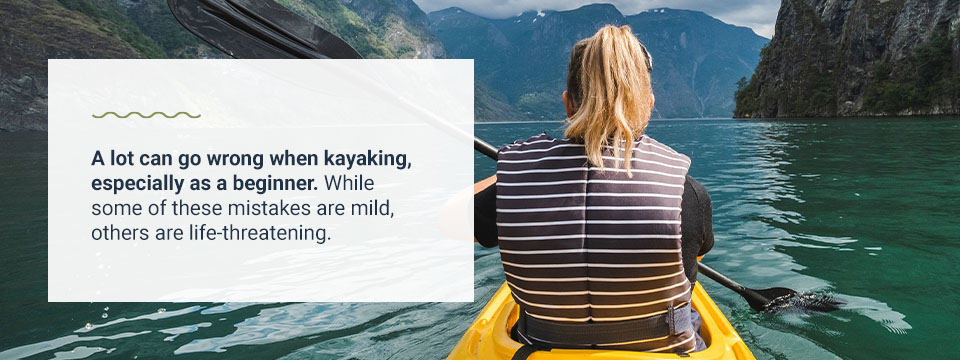
1. Kayaking Alone
No matter how experienced you are, never go kayaking alone. You don’t know when you’ll need help.
Kayaking isn’t like a cool afternoon nap that you enjoy alone, either. You’ll often have more fun when kayaking with some company.
2. Using Equipment That Doesn’t Fit
A kayak that’s too big, a life vest that doesn’t fit or a helmet that has room for two can make kayaking tiring and unsafe. For example, paddling in a kayak that you don’t fit in properly does not channel your energy to move the kayak in the direction you want.
3. Hugging Your Paddle
Paddle hugging can get you stressed out faster than you’d imagine. When you paddle hug, you hold the paddle too close to your body while paddling. This move is common with beginners.
Hugging your paddle can reduce the efficiency and fun of your paddling, so always hold your paddle away from your body when paddling.
Read this guide on how to paddle a kayak or canoe to learn more about paddling.
4. Panicking
The last thing you want to do when you think you’re in danger is to panic.
Whether you’re facing a heavy current, paddling white water or got thrown off your kayak, maintain a relaxed and calm mind. This mindset is the only way you can handle unexpected and threatening situations effectively.
5. Ignoring Proper Positioning
Throughout your adventure, it is necessary that you maintain a balanced sitting position.
Your body should not lean backward or forward — except when you need to counter the force an obstacle creates — and you must be properly and well-adjusted in your kayak.
Leaning forward reduces your ability to paddle with your core — the core is stronger than your arms — and delegates the paddling to your arms. This position can make paddling a drag and tiring.
6. Brushing Off Weather Forecasts and Rules
Don’t make the mistake of entering the water without first consulting and knowing the temperature of the water and the weather forecast for that day. When the conditions are not favorable, do not fall for the urge to go in — no matter how experienced you think you are when it comes to kayaking.
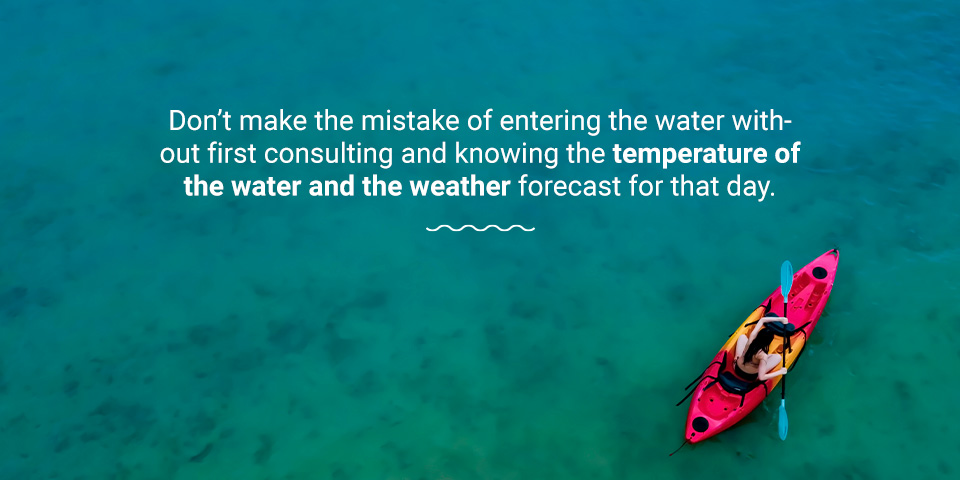
7. Testing Your Skills on Open Water
Beginners who want to learn the ropes of kayaking on high rapids and boisterous waves need to take a step back.
Open water is not the best place for you to test yourself, especially in bad weather. Ensure you know what you’re doing or go with an experienced instructor before venturing out into the water.
8. Trying to Impress Others
Go kayaking for fun and because you know how to, not because you want to impress someone with skills you don’t have yet. This mantra will ensure you do not engage in activities that might threaten your life.
Add Fun and Ease to Your Kayaking
So to put everything together, kayaking is fun, and something you should try if you haven’t. But the fun is in kayaking safe and smart.
This step is where some people hit a snag.
For example, a crucial part of kayaking is getting in and out of your kayak — especially on the shore. You’ll also experience different ways of getting in and out of your kayak based on the water level. Trying to get into your kayak in low-level waters can be easy, however, you may not say the same when trying to get into your kayak when the water level is high.
EZ Dock floating docks and launching systems provide just what you need to launch into the water fast and easy so you can spend more time paddling with friends and family.
These docks are how fun and easy kayaking becomes possible:
- Floating docks and launching systems: Systems like these mean you’re always at the level of the water and you can easily get in and out of your kayak at any time.
- Floating launching systems: EZ Launch® Residential makes gliding in and out of the water easy. Just like getting in and out of your garage. Our systems are also ADA accessible so anyone can enjoy the water.
EZ Dock floating docks and EZ Launch® Residential are easy to install and maintain, which gives you even more time to enjoy the water. Plus, they’re durable, can handle any weight, do not splinter and are cool to the feet at all times.
Check out our list of products to supercharge your kayaking and contact us for a free quote to discuss how we can add fun and ease to your next kayaking adventure.

